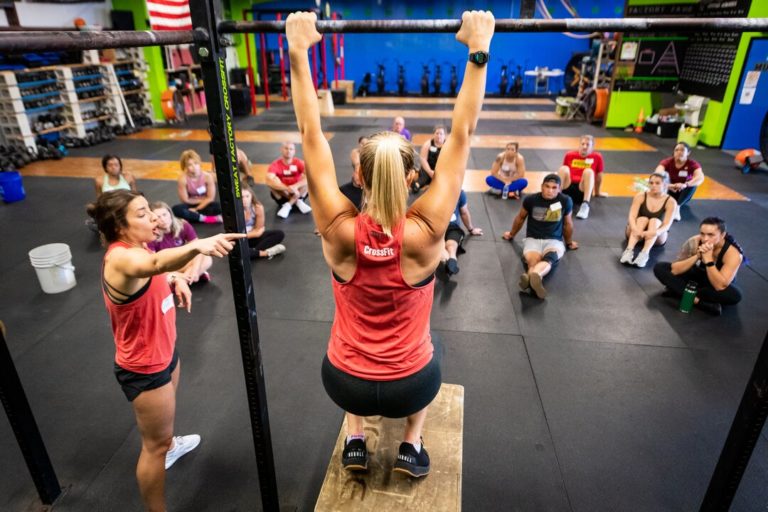It’s time to talk about kipping pull-ups. Which scenario resonates with you?
First Scenario: You look at the Workout of the Day and realize you’ll be doing ring rows once again because you still don’t have a pull-up.
Second Scenario: The Workout of the Day involves kipping pull-ups, and you wince because you know you have pain in your shoulder every time you do them, so you give up and resort to ring rows again.
Let’s break down these issues so you can better understand how to move toward Rx’d and implement pull-ups during your workouts.
“Why Can’t I Go Rx’d?”
Let’s delve into the common struggles with kipping pull-ups, an issue many of us can relate to. When we encounter kipping pull-ups in a workout, two main issues often surface.
First, athletes without pulling strength will resort to the SAME scaling option for years: the dreaded ring row. Don’t get me wrong, ring rows are a good pulling skill, but they don’t translate to getting pull-ups.
Next, athletes who don’t have strict strength often default to doing kipping pull-ups, but kipping pull-ups are NOT a scale for strict pull-ups.
So, what’s the solution? I have a few!
The Kipping Pull-Up
 The kipping pull-up is a combination of kipping mechanics and strict pull-ups. The best way to move toward the Rx’d version is to train parts of the whole. This involves training both the kip swing via the shoulders and lats while you move through the arch and hollow, and the strict pull-up, which builds scapular, grip, lat, and bicep strength. While this might seem overwhelming, you can break this down into two simple movements during workouts with the goal of building technique, strength (to also protect those shoulders from injury while kipping), and confidence. There are many options, but here’s a simple breakdown you can use as a template.
The kipping pull-up is a combination of kipping mechanics and strict pull-ups. The best way to move toward the Rx’d version is to train parts of the whole. This involves training both the kip swing via the shoulders and lats while you move through the arch and hollow, and the strict pull-up, which builds scapular, grip, lat, and bicep strength. While this might seem overwhelming, you can break this down into two simple movements during workouts with the goal of building technique, strength (to also protect those shoulders from injury while kipping), and confidence. There are many options, but here’s a simple breakdown you can use as a template.
21 Pull-Ups!
Imagine the workout of the day from CrossFit.com is Erin.
5 rounds for time of:
15 dumbbell split cleans
21 pull-ups
You might break up the 21 kipping pull-ups into two parts, where both parts add up to 21 reps per round.
 For Example:
For Example:
Beginner:
Complete 15 banded arch hollows + 6 toe-assisted pull-ups each round.
Intermediate:
Complete 11 kip swings + 10 toe-assisted pull-ups each round.
Both options break the skill into the parts of the whole. As you move through months of training, you can increase the “load” by dropping one foot off the box, eventually using the box to assist the pull-up, and then lifting your feet to work on the eccentric movement with your entire body weight.
Positional Work for the Kipping Pull-Up
It is essential to challenge yourself while working toward this skill. Start by breaking it down into the kip swing and the pulling portion without compromising the integrity of the skill itself. You will get to the Rx’d movement by building the foundation of this skill rather than changing the skill completely, as in a ring row.
Ring Rows vs. Pull-Ups
This brings us back to the start of the article, where I said I would explain why ring rows are an excellent pulling skill but do not translate well to the pull-up itself. Both ring rows and strict pull-ups are excellent bodyweight exercises. Still, they target different muscle groups and movement patterns due to the body’s orientation and the pull direction. Here are the key differences.
Pulling Plane
- Ring rows: Horizontal pulling (mid-back emphasis).
- Pull-ups: Vertical pulling (lat emphasis).
Grip and Stability
- Ring rows: Rings allow for natural wrist rotation, making it easier on the joints.
- Pull-ups: The fixed grip requires more demand on grip and joint stability.
Both are excellent pulling skills, but they train different muscle groups, so I rarely see athletes progress from ring rows to strict pull-ups.
Dynamics of the Kip Swing
It’s also important to note that the momentum of a kip swing can add three to five times your body weight on the bar and to protect the eccentric movement, you must have a solid amount of strict body weight pulling strength. This is also a big reason why the kipping pull-up is NOT a scaling option for the lack of strict pull-ups. It is quite the opposite. If you want to get better at kipping pull-ups, you should increase your strict pull-ups, as this is the strength foundation for adding intensity to the kipping pull-up.
Banded Pull-Ups — Yes or No?
I know many of you are asking, “But what about banded pull-ups?’ The easiest way for me to explain why a band is not the ideal option is this: If you have 65 lb on a barbell and you do a quarter squat because it’s too heavy and you can’t get below parallel and drive out of the hole to stand up, you wouldn’t squat to a band below parallel to bounce your way back up. Instead, you would take some weight off the barbell and continue working the full range of motion with a lighter weight. It is the same scenario with the band. The band does not allow you to feel the scapular pull for the initial portion of the pull-up. Here is a visual that explains this concept further.
Practice
Success in the gymnastics portion of CrossFit requires regular practice, not just attempts during the workout. Therefore, doing drills and warm-ups outside class will help you feel even more prepared the next time pull-ups appear in the workout.
Do these movements three times a week for the next three weeks.
Day 1
6 rounds (3 rounds of each skill below), 30 seconds work/30 seconds rest:
- Beginner – Alternate rounds with arch snap to hollow and scap pull-ups
- Intermediate – Alternate rounds arch snap to hollow and weighted scap pull-ups [25/15 dumbbell between legs]
Day 2
6-5-4-3-2-1 reps, rest as needed to be successful at all sets (approx 30-60 seconds):
- Beginner – Banded arch to hollows + scap pull-ups + toe-assisted pull-ups
- Intermediate – Kip swing + scap pull-ups + strict pull-ups
Day 3
3 rounds, 1 minute of rest between sets:
- Beginner – 5 scap pull-ups right into max reps of toe-assisted pull-ups
- Intermediate – 10 scap pull-ups right into max reps of strict pull-ups
Drills and Warm-Ups
A few quality drills and warm-ups include:
The Main Take-A-Way
Remember, any fitness is great fitness, but if your goal is to get your first pull-up, training by breaking up parts of the whole is the same concept as making sure you have all the ingredients in a recipe to make the best meal possible.
About the Author
 Pamela Gagnon is the co-creator of Performance Plus Programming and the Get Your First Strict Pull-Up program. She is a four-time Masters CrossFit Games athlete and a former D1 gymnast. As a CF-L2, Gagnon was a lead coach for eight years with the CrossFit Gymnastics Course. She currently writes gymnastics programming for CrossFit Mayhem.
Pamela Gagnon is the co-creator of Performance Plus Programming and the Get Your First Strict Pull-Up program. She is a four-time Masters CrossFit Games athlete and a former D1 gymnast. As a CF-L2, Gagnon was a lead coach for eight years with the CrossFit Gymnastics Course. She currently writes gymnastics programming for CrossFit Mayhem.
Comments on Let’s Talk About Kipping Pull-Ups
Thanks!
I have been working for 3 years to get my pull ups. I am going to implement the strategy above and hopefully finally get them. Thanks for the great info!
Let’s Talk About Kipping Pull-Ups
2